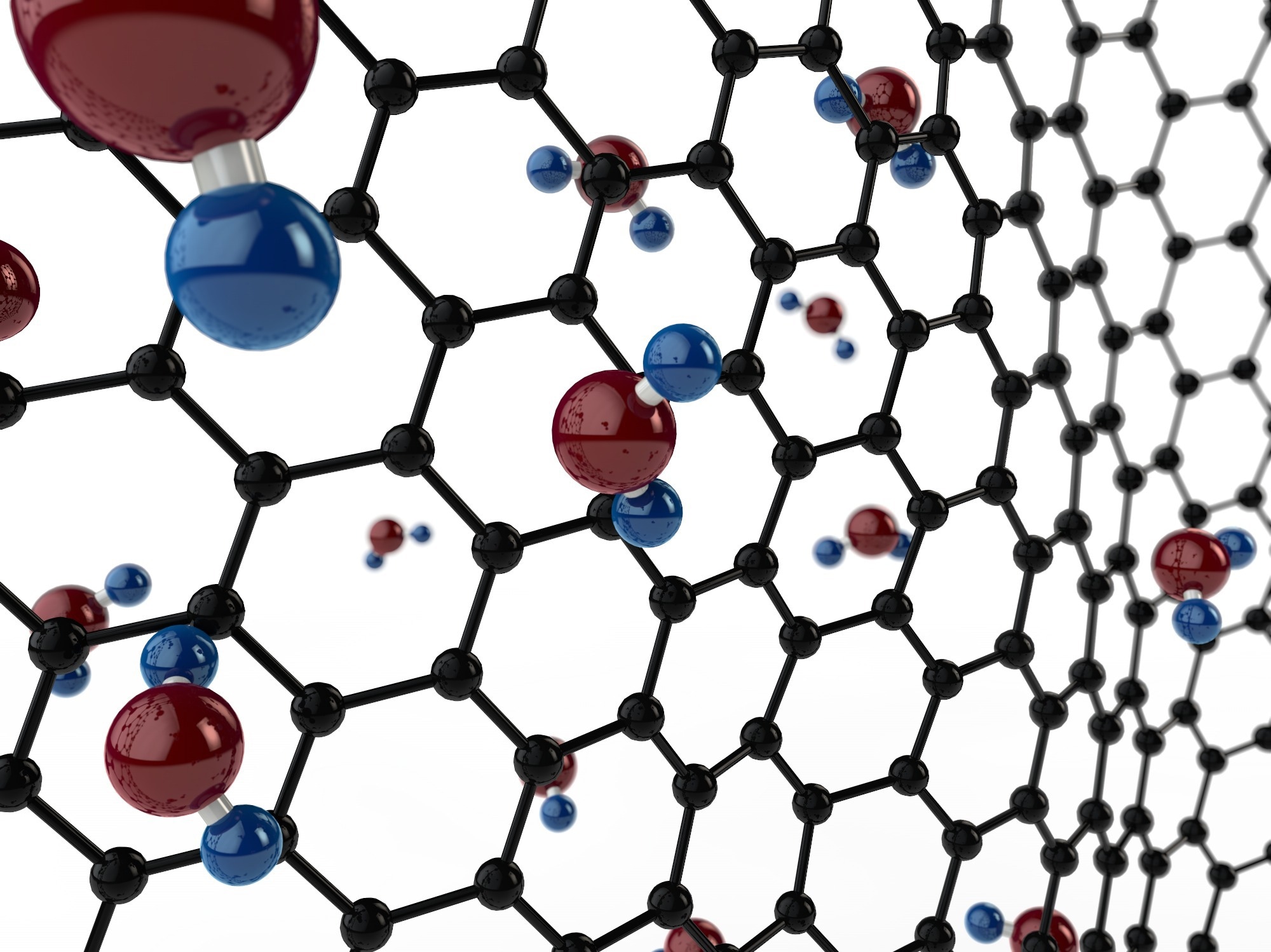In a recent article published in the journal Scientific Reports, researchers investigated the efficacy of two advanced composite materials—graphitic carbon nitride/graphene and MIL-101(Fe)/graphene—in adsorbing common pharmaceutical pollutants such as acetaminophen, caffeine, and sulfamethoxazole. The research employs molecular dynamics simulations to provide insights into the adsorption mechanisms and capacities of these materials, contributing to the development of effective water treatment solutions.

Image Credit: 3DStach/Shutterstock.com
Background
Pharmaceutical contaminants are an environmental concern due to their persistence and potential impact on ecosystems and human health. Traditional wastewater treatment methods often struggle to effectively remove these compounds, prompting research into materials with improved adsorption capabilities.
Graphitic carbon nitride (g-C₃N₄) and metal-organic frameworks (MOFs) like MIL-101(Fe) are of interest due to their high surface areas and structural properties, which make them suitable for pollutant removal. Studies suggest that combining these materials with graphene can enhance their stability and adsorption performance.
This research simulates the interactions between these composites and pharmaceutical contaminants, assessing their potential for practical water purification applications.
The Current Study
This study used molecular dynamics simulations to evaluate the adsorption performance of two composite materials: graphitic carbon nitride/graphene (g-C₃N₄/graphene) and MIL-101(Fe)/graphene. The first step involved constructing and optimizing the nanocomposite structures with density functional tight binding (DFTB) methods, supported by the Amsterdam Modeling Suite.
The simulation environment was configured to reflect realistic conditions, with controlled parameters for temperature, pressure, and density to enhance result accuracy. Adsorption simulations ran over 40 picoseconds, during which the interactions between the composites and pharmaceutical contaminants—acetaminophen, caffeine, and sulfamethoxazole—were analyzed.
Reactive Forcefield (ReaxFF) software was utilized to calculate the van der Waals interactions and the adsorption capacities of the materials. Specifically, simulations involved the adsorption of 80 molecules of each contaminant for the MIL-101(Fe)/graphene composite and 70 molecules for the g-C₃N₄/graphene composite. The exothermic energies associated with the adsorption processes were computed to evaluate the thermodynamic stability of the interactions.
Results and Discussion
The results showed that the MIL-101(Fe)/graphene composite exhibited a significantly higher adsorption capacity for pharmaceutical contaminants than the g-C₃N₄/graphene composite. Specifically, the MIL-101(Fe)/graphene adsorbed 80 molecules each of acetaminophen, caffeine, and sulfamethoxazole, with corresponding exothermic energies of −1174, −1630, and −2347 MJ/mol. In contrast, the g-C₃N₄/graphene composite adsorbed only 70 molecules of each contaminant, with lower exothermic energies of −924, −966, and −1268 MJ/mol, respectively.
These findings suggest that MIL-101(Fe)/graphene has a higher pollutant removal capacity and stronger interactions with contaminants, likely due to its structural features and the presence of metal ions enhancing adsorption.
The study also highlighted the remarkable resistance of both composites to surface clogging, a common issue in adsorption processes that can hinder performance over time. This property is particularly important for practical applications in water treatment, as it suggests that these materials could maintain their effectiveness over extended periods of use.
The molecular dynamics simulations provided insights into the adsorption mechanisms, showing that van der Waals interactions are key to binding pharmaceutical contaminants to the composite surfaces. Overall, these results highlight the potential of these materials for addressing pharmaceutical pollutants in water sources.
Conclusion
In conclusion, this study demonstrated the superior adsorption capabilities of the MIL-101(Fe)/graphene composite over the g-C₃N₄/graphene composite for removing pharmaceutical contaminants from water.
The molecular dynamics simulations provided insights into the adsorption processes, highlighting the role of van der Waals interactions and the thermodynamic stability of the mechanisms involved. Given growing concerns over pharmaceutical pollutants in water, these findings support efforts to develop effective water treatment solutions.
Future research could involve experimental validation of these simulation results and testing additional composite materials to further enhance adsorption. This study’s insights offer a foundation for developing approaches to reduce pharmaceutical contaminants' impact on public health and the environment.
Journal Reference
Ibrahim Q., Gharbia S. (2024). Adsorption performance of g-C3N4/graphene, and MIL-101(Fe)/graphene for the removal of pharmaceutical contaminants: a molecular dynamics simulation study. Scientific Reports. DOI: 10.1038/s41598-024-75443-9, https://www.nature.com/articles/s41598-024-75443-9